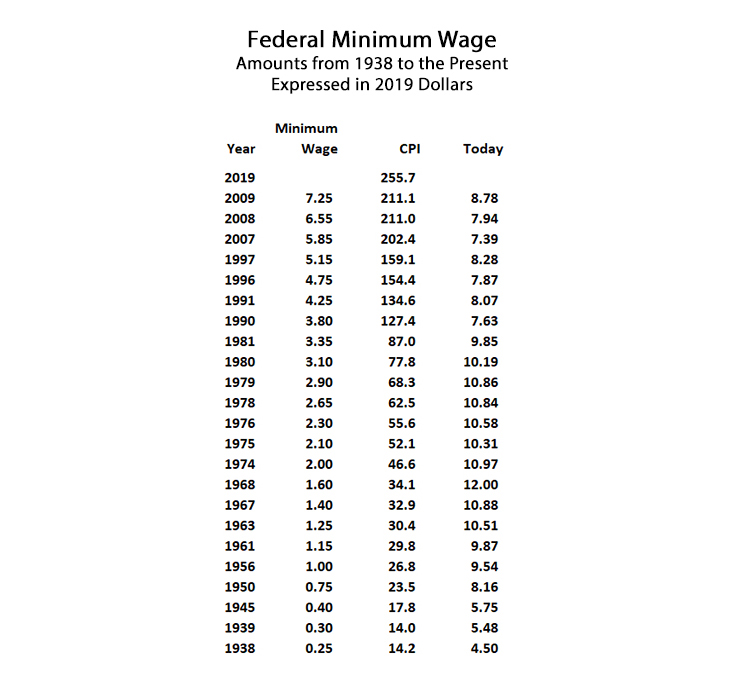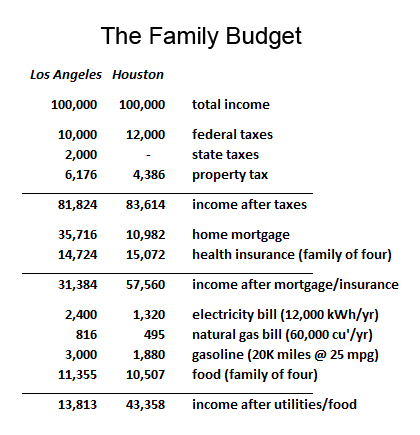Usually when billionaires run for political office, it is reasonable to expect they have a basic understanding of economics. In the case of presidential candidate Tom Steyer, however, one cannot make that leap of faith. Either Steyer has no understanding of economics whatsoever, which is extremely unlikely, or he does and does not care, or he is a pandering liar.
On February 9, speaking in South Carolina, Steyer said “he would call for a $22 per hour minimum wage if elected president.” This ups the ante on Steyer’s competitors in the Democratic presidential primary race, who are calling for an increase to $17 per hour.
Currently, the federal minimum wage is $7.25 per hour. If Tom Steyer were president, that rate would triple. Examining the consequences of such a move brings into sharp focus the dangerous absurdity of Democrat proposals. It offers additional reasons to vote for Republicans not necessarily because they are Republicans, but because they are not Democrats.
Shown on the chart below is the history of the federal minimum wage since it was first established in 1938. The first column shows the actual, nominal, minimum wage in each year the amount was raised. The middle column displays the consumer price index in each of those years. The column on the right then calculates what the minimum wage was historically, if expressed in 2019 inflation adjusted dollars.
As can be seen, if the minimum wage set back in 1938, 25 cents per hour, were expressed in inflation adjusted 2019 dollars, it would only be $4.50. Also evident is that the highest level the inflation adjusted minimum wage ever got was in 1979, when it was set – in 2019 dollars – at $10.86 per hour.
It’s just fine to argue about the need for some minimum wage. There are good arguments on both sides of that question. But what Tom Steyer is proposing is at best ridiculous, and he knows it. The obvious consequence of a minimum wage this high is that it makes it impossible for small businesses to stay profitable. The restaurant industry is a prime example. Large corporate chains automate and raise their prices. Small mom and pop restaurants go out of business.
In general, the job killing impact of an artificially high minimum wage is well documented based on the experiences in cities where it’s been implemented. Businesses that can’t adapt simply change jurisdictions or they close shop. And it’s not only these small businesses that become victims of a high minimum wage. These entry level jobs that go away create unemployment for people who would otherwise be entering the workforce and beginning to earn income and acquire skills.
Less obvious but equally significant is the impact on indexed wage scales. A relatively unknown but very common feature of collective bargaining agreements is that negotiated rates of pay are automatically increased when the minimum wage increases. Raising the minimum wage at any level, local, state or national, automatically raises wages across unionized workforces in the private and public sector. The ripple effect is therefore significant. When the minimum wage goes up, it drives consumer prices up across a host of industries that have to pass through the increased payroll costs, it can challenge the ability of businesses to survive if they have unionized workers at any level of wages, it drives businesses offshore, and it increases government payroll expenses leading to higher taxes.
What Steyer, the other Democratic candidates, and their union backers are doing is justified by a cost-of-living for Americans that has not been matched by increases in the average wage. That is a powerful argument, but artificially increasing wages will not solve that problem. When driving companies out of business, increasing unemployment, driving up consumer prices, and driving up tax rates is the consequence of increasing the minimum wage, then increasing the minimum wage is a fool’s errand. There is another solution, which is to lower the cost-of-living, and to lower the supply of labor.
America Needs to Lower the Cost-of-Living, Not Raise Minimum Wages
The sad irony is that these solutions used to be part of the union playbook. In past decades, unions fought for efficiently ran public infrastructure projects. These projects, often publicly funded but not rife with the padded budgets and paralytic bureaucratic delays that we see today, were vital elements in delivering a lower cost-of-living to the average American. In past decades, enabling infrastructure such as freeways, connector roads, reservoirs, aqueducts, water treatment plants, schools and parks were built swiftly and largely out of operating budgets. As a result, cities could expand, and homes were affordable, utility bills were affordable, and taxes were low.
Today these enabling infrastructure projects cost two to three times as much, and take five to ten times as long to complete. Most of the time they are funded via assessments on private homebuilders and developers, greatly increasing the market price of homes. If public funds are used, the money comes not out of operating budgets, but via public bond financing. What happened?
In the simplest terms possible, what happened is that America’s unions stopped fighting for the interests of all workers, and, for all practical purposes, joined forces with the corporations who used to be their adversaries. Oh sure, there are still strikes, and management and labor still quarrel, but they both are representing groups who have acquired and keep their privilege thanks to over-regulation. Unionized employees receive over-market wages, and corporations consolidate their market share against competitors with less financial resilience.
In the government sector, it’s even worse. Across blue-state America, unions control local and state elections, electing their own bosses. Why on earth would these union controlled bureaucracies fund infrastructure out of operating budgets, when instead they can use that money to pay themselves over-market wages, and fund pensions that are worth several times what Social Security benefits are worth to private sector workers?
Unions also used to fight the environmentalist lobby, but today, in addition to reaching a rapprochement with monopolistic corporations, they have allowed environmentalists to dictate their agenda. And why not? Environmentalists may only approve of one in five badly needed infrastructure projects, but who cares if each project is going to incur labor costs that are five times what they might have been if budgets weren’t padded?
This is easily exemplified by two California examples (of course), high speed rail and affordable housing. Construction of California’s “bullet train” still chugs along at a snails pace, but unionized workers have already been paid hundreds of millions, if not billions, to construct a small, overbuilt fraction of this useless monstrosity. But the environmentalists love it.
Similarly, the average cost of government funded affordable housing in California is now over $500,000 per apartment unit. But who cares? Environmentalist attorneys collect lawsuit settlements, public bureaucrats collect astronomical permit fees, consultants cash in on the required studies by experts, nonprofits build their empires, developers get subsidies and tax breaks, and unions operate under project labor agreements which means a swollen headcount and swollen wages.
Everybody wins except the normal, underprivileged, general public and the taxpayer.
What this points to is something bigger than unions, but very much related to the call for a higher minimum wage. What proponents of big government have done is over-regulate the economy, creating artificial scarcity which translates into an unaffordable cost-of-living for ordinary workers. They made housing unaffordable, then brought in government to build unaffordable “affordable housing.” And to cope with the high cost of housing and pretty much everything else that can’t be imported from overseas sweatshops, the bring in government to raise the minimum wage.
There was a time when unions performed an invaluable role in American society, because they stood up for all workers and supported policies that benefit all workers. This isn’t to say there weren’t aspects of unions that were and remain problematic. But on two key issues, unions have abandoned their own legacy and they have abandoned their membership.
Unions in America today no longer offer a counterbalance to the environmentalist lobby and as a result they no longer support vital enabling infrastructure. Even worse, they are demanding a massive increase to the minimum wage instead of calling for realistic restrictions on immigration, which would naturally force market rates for labor to rise.
Many high-profile Democrats in America, such as the bird brained Alexandria Ocasio Cortez, do not properly understand history or economics. Their ignorance can be forgiven, if nothing else.
Tom Steyer, however, does not get a pass. He knows exactly what he’s doing. And while he will never, ever be president – and he knows that, too – the hundreds of millions he’s investing in the 2020 election will influence countless voters to vote against the interests of their own fortunes as well as the fortunes of this nation.
This article originally appeared on the website American Greatness.
* * *
Edward Ring is a contributing editor and senior fellow with the California Policy Center, which he co-founded in 2013 and served as its first president. He is also a senior fellow with the Center for American Greatness, and a regular contributor to the California Globe. His work has appeared in the Los Angeles Times, the Wall Street Journal, the Economist, Forbes, and other media outlets.
To help support more content and policy analysis like this, please click here.



